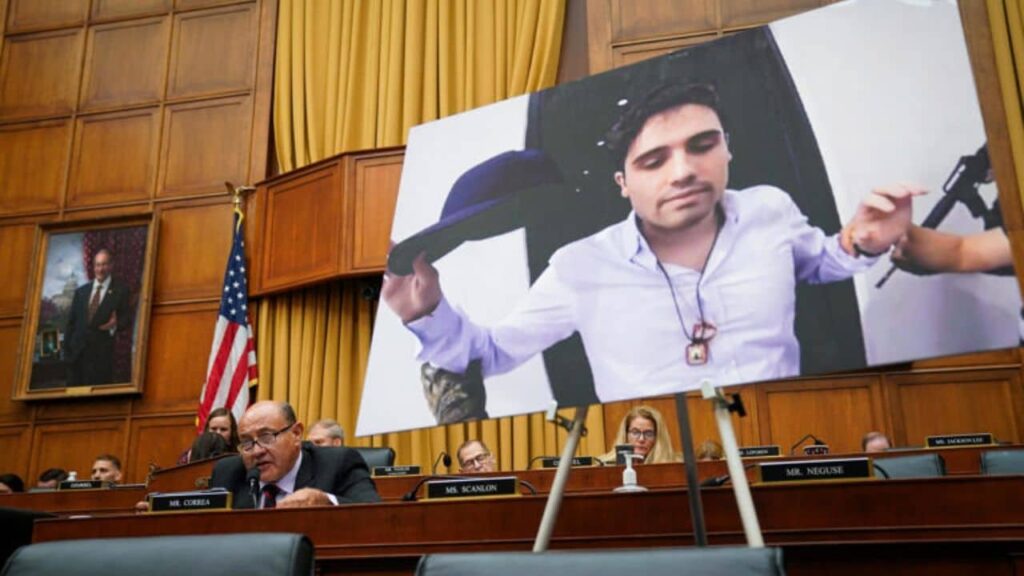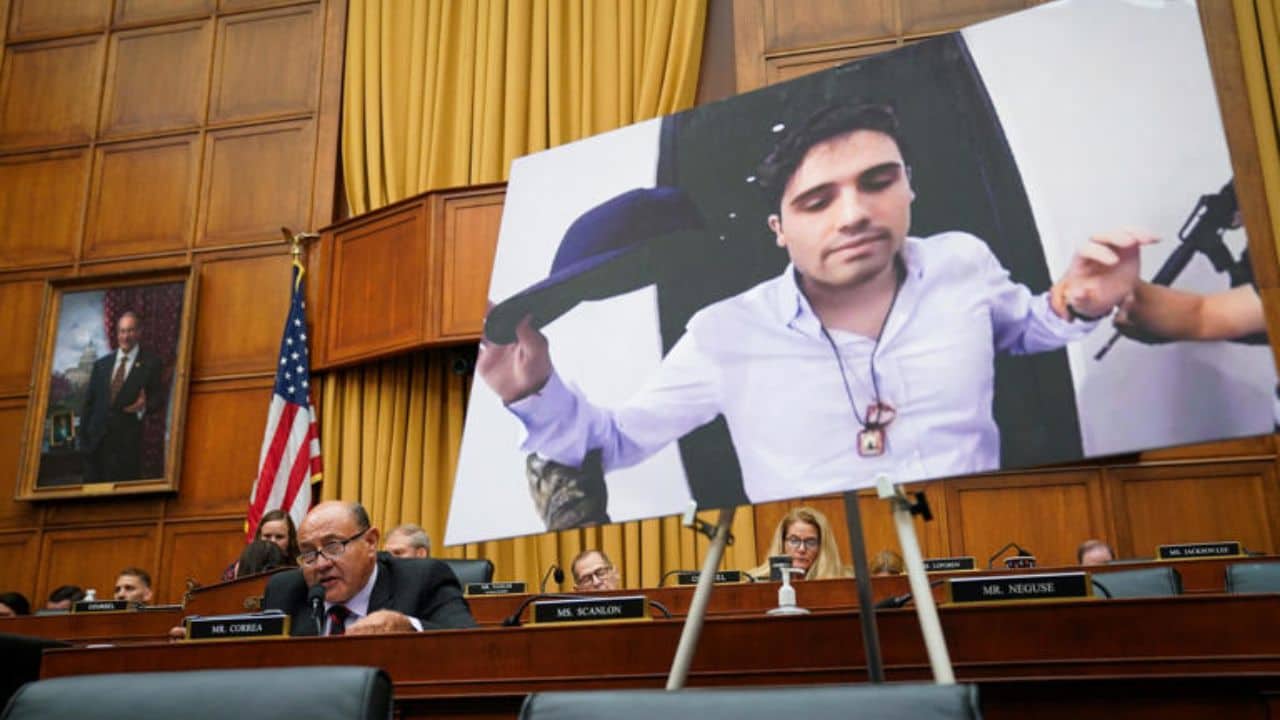El Chapo, Joaquín Guzmán, Sinaloa Cartel, Guzmán López arrest, El Mayo, Ismael Zambada García, Los Chapitos, drug trafficking, El Chapo prison escape, drug lord, El Chapo sons, fentanyl trafficking, Mexican cartels, El Chapo biography
Explore the life of Joaquín “El Chapo” Guzmán, the infamous leader of the Sinaloa Cartel, and the recent arrest of his son, Joaquín Guzmán López. Learn about El Chapo’s rise to power, notorious prison escapes, and the ongoing influence of his criminal empire.

Who is El Chapo? What to Know About the Infamous Drug Lord Amid Son’s Arrest
Joaquín “El Chapo” Guzmán is a name that has become synonymous with drug trafficking, violence, and high-profile prison escapes. As the leader of Mexico’s Sinaloa Cartel, El Chapo has left an indelible mark on the global narcotics trade. His recent notoriety has been further amplified by the arrest of his son, Joaquín Guzmán López, alongside cartel leader Ismael Zambada García, known as “El Mayo,” in Texas. This article delves into the life of El Chapo, his criminal empire, and the ongoing saga of his family’s involvement in drug trafficking.
Early Life and Rise to Power
Joaquín Archivaldo Guzmán Loera, better known as El Chapo, was born on April 4, 1957, in La Tuna, a small village in the Mexican state of Sinaloa. Growing up in poverty, Guzmán entered the drug trade in his early teens, initially working with drug lord Héctor Luis Palma Salazar. He quickly rose through the ranks, displaying a ruthless efficiency that caught the attention of Miguel Ángel Félix Gallardo, the founder of the Guadalajara Cartel.
Following the arrest of Félix Gallardo in 1989, the cartel splintered, and Guzmán took control of the Sinaloa Cartel. Under his leadership, the cartel grew into one of the most powerful and dangerous drug trafficking organizations in the world.
The Sinaloa Cartel
The Sinaloa Cartel is renowned for its sophisticated operations and extensive reach. According to InSight Crime, a non-profit think tank, it is the “largest and most powerful drug trafficking organization in the Western Hemisphere.” The cartel’s operations include the production, smuggling, and distribution of a variety of narcotics, including cocaine, heroin, methamphetamine, and fentanyl.
The cartel’s influence extends beyond drug trafficking. Some factions are involved in taxing other criminal networks, including human traffickers. This extensive criminal network has allowed the Sinaloa Cartel to maintain its dominance despite the arrests of several key leaders.
El Chapo’s Notorious Escapes
El Chapo’s criminal career is marked by his ability to evade capture, often in dramatic fashion. His first significant arrest came in 1993 when he was captured in Guatemala and extradited to Mexico. While serving a 20-year sentence for drug trafficking, Guzmán orchestrated his first escape in 2001. He reportedly spent $2.5 million in bribes and other costs to ensure his escape from a maximum-security prison by hiding in a laundry cart.
In February 2014, Guzmán was recaptured at a beach resort in Mazatlán, Sinaloa, but his time in custody was short-lived. In July 2015, he escaped from another maximum-security prison through a mile-long tunnel that led directly from his cell’s shower area. The tunnel was equipped with lighting, ventilation, and a motorcycle on tracks, highlighting the cartel’s resources and Guzmán’s determination to evade justice.
The Capture and Extradition
El Chapo’s second escape triggered a massive manhunt. In October 2015, he met with Mexican actress Kate del Castillo and American actor Sean Penn for an interview published in Rolling Stone Magazine. The controversial article drew global attention and ultimately aided authorities in tracking him down. Guzmán was recaptured in January 2016 and extradited to the United States in January 2017.
In the U.S., Guzmán faced numerous charges, including drug trafficking, money laundering, and murder. In 2019, he was sentenced to life in prison plus 30 years by a federal judge in Brooklyn. During his trial, prosecutors presented evidence of his involvement in a vast drug trafficking network and detailed his role in orchestrating murders, kidnappings, and acts of torture.
The Chapitos: El Chapo’s Legacy Continues
Despite El Chapo’s incarceration, his legacy lives on through his children, who have taken active roles in the Sinaloa Cartel. Joaquín Guzmán López, one of El Chapo’s four sons known as “Los Chapitos” or “the little Chapos,” has become a key figure in the cartel’s operations. The Chapitos have been credited by U.S. authorities with rebuilding their father’s drug empire, particularly in the production and trafficking of fentanyl, a powerful synthetic opioid.
The arrest of Joaquín Guzmán López in Texas marks a significant development in the ongoing efforts to dismantle the Sinaloa Cartel. Guzmán López was arrested alongside Ismael Zambada García, or “El Mayo,” a long-time leader of the cartel who has managed to evade capture for years. El Mayo is considered the strategic mastermind behind the cartel’s operations, maintaining a lower profile compared to the headline-grabbing antics of El Chapo.
The Impact of Their Arrest
The arrests of Guzmán López and Zambada García are seen as a major blow to the Sinaloa Cartel. According to DEA Administrator Anne Milgram, these arrests strike at the heart of the cartel responsible for the majority of drugs, including fentanyl and methamphetamine, killing Americans from coast to coast. Milgram emphasized that El Mayo and Guzmán López will soon face justice in a U.S. court of law.
Ongoing Legal Battles
The Chapitos face extensive charges in multiple U.S. jurisdictions, with million-dollar bounties placed on their capture. Despite their denials, U.S. authorities have linked them to significant drug trafficking activities. Ovidio Guzmán, another of El Chapo’s sons, was extradited to the U.S. in September 2023 after his arrest in Culiacán earlier that year. He is currently awaiting trial, adding to the mounting legal pressures on the Guzmán family.
The Legacy of El Chapo
El Chapo remains one of the most infamous figures in modern criminal history. His life story, marked by his rise from poverty to becoming the leader of a powerful drug cartel, his dramatic escapes, and his ultimate capture and extradition, continues to captivate public imagination.
Guzmán’s impact on the drug trade cannot be overstated. He transformed the Sinaloa Cartel into a global enterprise, orchestrating the trafficking of vast quantities of drugs into the United States and other countries. His methods, characterized by extreme violence and corruption, set a precedent for other drug trafficking organizations.
Conclusion
The arrest of Joaquín Guzmán López and Ismael Zambada García is a significant milestone in the ongoing battle against the Sinaloa Cartel. However, the cartel’s deep-rooted influence and extensive network mean that the fight is far from over. El Chapo’s legacy continues through his children, who have taken the reins of the cartel and perpetuated its operations.
As authorities continue to target key figures within the Sinaloa Cartel, the story of El Chapo and his family’s involvement in the drug trade serves as a stark reminder of the challenges in combating organized crime. The tale of El Chapo is one of ambition, power, and the far-reaching impact of the illegal drug trade, highlighting the complexities and dangers that law enforcement agencies face in their efforts to bring such criminals to justice.
Read More
